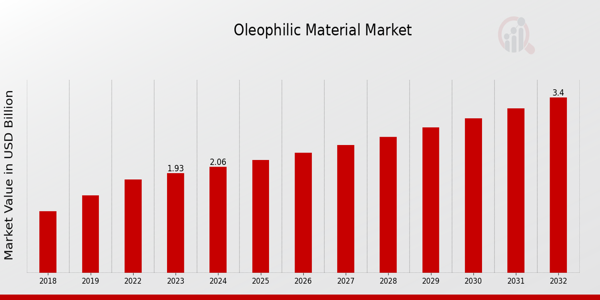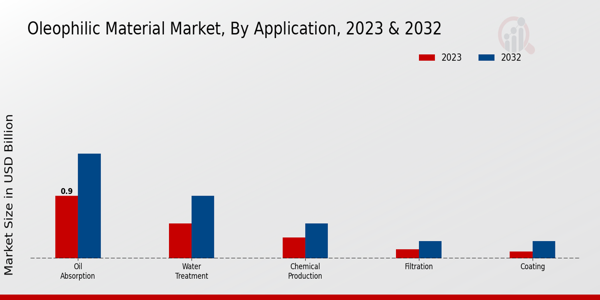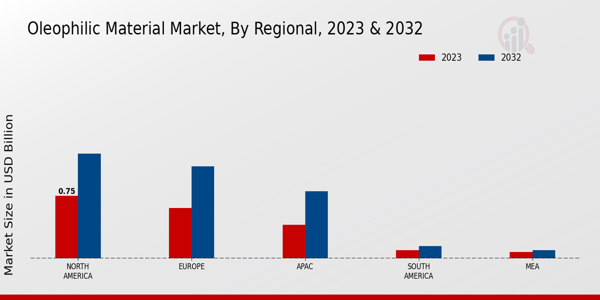Global Oleophilic Material Market Overview
The Oleophilic Material Market Size was estimated at 2.19 (USD Billion) in 2024. The Oleophilic Material Market is expected to grow from 2.33 (USD Billion) in 2025 to 4.11(USD Billion) by 2034. The Oleophilic Material Market CAGR (growth rate) is expected to be around 6.5% during the forecast period (2025 - 2034).
Key Oleophilic Material Market Trends Highlighted
The growing demand for eco-friendly products is propelling the remarkable expansion of the Oleophilic Material Market. The use of oleophilic materials has increased in a number of industries, including industrial, oil and gas, and marine, as a result of growing awareness of oil spills and the necessity for efficient cleanup techniques.
Regulations designed to lessen environmental effects and encourage sustainable behaviors are mostly responsible for this change.
Furthermore, new oleophilic products with improved performance and efficiency have been made possible by developments in material science. In the field of bio-based oleophilic materials, there are a lot of untapped possibilities.
As industries seek sustainable alternatives to synthetic products, companies can capitalize on the growing consumer preference for eco-friendly options. Emerging markets, particularly in Asia-Pacific and Latin America, hold potential for product expansion and development, driven by the increasing industrial activities and stringent regulatory frameworks.
Moreover, collaborations between manufacturers and research institutions could lead to breakthroughs in oleophilic technology, creating more effective and safer products for various applications. Recent trends indicate a shift towards greater customization and specialization of oleophilic materials to cater to specific industry needs.
Companies are investing in research and development to create tailored solutions that address unique challenges posed by different environments. Additionally, the use of digital technologies and smart materials is on the rise, enabling real-time monitoring and assessment of cleanup efforts.
This focus on innovation is expected to drive competition and foster growth within the market, creating a dynamic landscape for both established players and new entrants.

Source: Primary Research, Secondary Research, MRFR Database and Analyst Review
Oleophilic Material Market Drivers
Increasing Demand from Various Industries
The Oleophilic Material Market is witnessing a significant surge in demand driven by its extensive applications in various sectors such as oil and gas, petrochemicals, and environmental cleanup.
As industrial activities escalate around the world, the need for oleophilic materials has dramatically increased, particularly in regions with significant oil exploration and production activities.
These materials are essential for effectively separating oil from water, which is increasingly critical in maintaining environmental standards and compliance within the industry.
Furthermore, the rise in oil spills and other marine pollution incidents underscores the necessity for efficient cleanup solutions, thereby propelling market growth. High-performance oleophilic materials are also sought after for their ability to adsorb oil and other hydrocarbons in diverse applications.
Aside from the traditional sectors, advancements in technology and rising innovation are opening new avenues for oleophilic materials, leading to expanded usage in protective coatings, absorbents, and filtration systems.
As more companies recognize the inherent benefits of these materialsincluding efficiency and effectiveness in oil recovery and remediationdemand is expected to rise sharply, contributing positively to the market's overall trajectory.
Technological Advancements
Technological advancements play a pivotal role in shaping the Oleophilic Material Market. The continuous evolution of material science has resulted in the development of more efficient and effective oleophilic materials that cater to a variety of applications.
Enhanced formulations, including the use of novel polymers and nanotechnology, are creating opportunities for products that can adsorb oil at unprecedented rates while maintaining sustainability and cost-effectiveness.
As manufacturers invest in research and development to create innovative solutions, the overall efficiency of these materials improves, making them more appealing to a broader range of industries.
This constant flow of innovation is driving market growth as businesses seek out the latest technologies to meet regulatory demands and operational efficiency goals.
Environmental Regulations and Awareness
The increasing stringency of environmental regulations and growing public awareness regarding environmental protection are significantly driving the Oleophilic Material Market. Governments worldwide are implementing stringent regulations to mitigate the environmental impacts of oil spills and other hydrocarbon-related incidents.
Industries are under pressure to comply with these regulations, leading to an increased adoption of oleophilic materials designed to facilitate oil recovery and environmental cleanup.
This trend is not merely a response to regulations, as the rise in consumer consciousness surrounding environmental issues is prompting companies to adopt more sustainable practices.
Businesses are increasingly investing in oleophilic solutions to improve their environmental impact, paving the way for substantial market growth in the years to come.
Oleophilic Material Market Segment Insights:
Oleophilic Material Market Application Insights
The Oleophilic Material Market, particularly in the Application sector, is poised for substantial growth, reflecting a comprehensive understanding of its various applications.
In 2023, the Oil Absorption application commanded a significant market share of 0.9 USD Billion. This segment was crucial due to its increasing demand in industries dealing with oil spills and industrial waste management, highlighting its essential role in environmental remediation processes.
Following closely was the Water Treatment application, valued at 0.5 USD Billion. This segment played a vital role in improving water quality, thereby ensuring sustainable practices in industrial operations and urban water management, which is becoming increasingly important with rising environmental concerns.
The Chemical Production segment, though smaller at 0.3 USD Billion, signified the importance of oleophilic materials in facilitating various chemical reactions and processes, thereby contributing to production efficiency in the chemical industry.
In terms of niche applications, the Filtration segment, worth 0.13 USD Billion, provided critical benefits in maintaining equipment longevity and performance across various sectors, while the Coating segment, although valued at 0.1 USD Billion, offered protective features that enhance product durability and aesthetic appeal in manufacturing processes.
Each application contributed to the overall market dynamics, reflecting broader trends of sustainability and increased industrial focus on efficient resource management.
The combined valuation of these applications was a testament to the significant growth trajectory of the Oleophilic Material Market, enhancing its relevance across numerous industries engaged in environmental management, resource conservation, and production optimization.

Source: Primary Research, Secondary Research, MRFR Database and Analyst Review
Oleophilic Material Market Material Type Insights
The Oleophilic Material Market showcases a diverse range of material types that significantly contribute to the industry's dynamics. Among these, Polymeric Materials play a pivotal role due to their versatility and efficiency in various applications, such as oil spill management and filtration systems.
Natural Materials are increasingly gaining traction for their eco-friendly attributes, appealing to a growing segment of environmentally conscious consumers. Composite Materials combine the strengths of different materials, enhancing durability and performance, making them essential in industrial applications.
Additionally, Nanomaterials, characterized by their unique properties at the nanoscale, hold significant potential for innovations in oil recovery and absorption technologies. The Oleophilic Material Market segmentation reflects these trends, with each material type addressing specific needs in various sectors, thus driving market growth.
Emerging technologies and an increasing emphasis on sustainable practices are expected to further propel the advancements in these material types, benefitting the overall industry. The Oleophilic Material Market statistics demonstrate the potential for growth within these segments, aligning with evolving market demands.
Oleophilic Material Market End Use Industry Insights
The Oleophilic Material Market showcases its significance across various end-use industries. The oil and gas sector plays a crucial role, as oleophilic materials are essential for efficient oil recovery and management, reflecting the industry's demand for enhanced operational performance.
The Automotive industry has seen increased usage of these materials in applications such as coatings and components, driven by the need for improved fuel efficiency and performance attributes. In Marine applications, oleophilic materials are significant for oil spill remediation and precision engineering, ensuring safety and environmental compliance.
The Aerospace sector benefits from lightweight oleophilic materials that enhance fuel efficiency and durability in aircraft components, ultimately supporting the aviation industry's growth. The Environmental segment continues to grow due to the rising importance of pollution control and resource management, prompting innovative solutions that leverage oleophilic materials.
Overall, the diverse applications across these industries underscore the strategic importance of the Oleophilic Material Market, amplifying market growth through innovation and a heightened focus on sustainability.
Oleophilic Material Market Form Insights
The Oleophilic Material Market shows significant promise for growth over the coming years. The Form segment within this market comprises various material types, such as Granules, Sheets, Powders, and Fibers, each serving critical functions in industrial and commercial applications.
Granules are particularly favored for their versatility in manufacturing processes, while Sheets have become increasingly important due to their applications in insulation and surface protection. Powders, known for their high surface area, offer efficient performance in filtration and oil recovery systems.
Fibers play a substantial role in the textile industry, reinforcing the demand for oleophilic properties. The overall market benefits from increasing industrial applications and the growing focus on eco-friendly materials, although it faces challenges like raw material costs and technological limitations.
Market growth is bolstered by rising environmental concerns and stringent regulations, leading to a greater interest in sustainable oleophilic materials.
The diverse Form segment represents a key component of the Oleophilic Material Market statistics, contributing to the overall industry revenue and driving innovation in formulation and application development.
Oleophilic Material Market Regional Insights
The Oleophilic Material Market presents diversified opportunities across its Regional segmentation, highlighting distinct dynamics within each area. North America led with a valuation of 0.75 USD Billion in 2023, expected to reach 1.25 USD Billion by 2032, showcasing its significant demand in industries like oil recovery and environmental cleanup.
Europe followed closely with an initial valuation of 0.6 USD Billion, projected to grow to 1.1 USD Billion, driven by sustainability initiatives and technological advancements.
The Asia-Pacific (APAC) region, while smaller at 0.4 USD Billion, held growth potential, especially with increasing industrialization, which is anticipated to elevate it to 0.8 USD Billion.
South America and the Middle East Africa (MEA) represented the emerging markets within this landscape, starting at 0.1 USD Billion and 0.08 USD Billion, respectively, in 2023, reflecting slower but steady growth trends towards 0.15 USD Billion and 0.1 USD Billion by 2032.
Overall, the Oleophilic Material Market segmentation illustrated a robust landscape where North America and Europe significantly dominated, largely due to established market infrastructure and regulatory support, while APAC showed promising potential for future growth driven by its rapid industrialization efforts and environmental commitments.

Source: Primary Research, Secondary Research, MRFR Database and Analyst Review
Oleophilic Material Market Key Players and Competitive Insights:
The Oleophilic Material Market is characterized by its dynamic landscape, with various players actively competing to capture a substantial share. This market comprises materials that have a strong affinity for oils and hydrocarbons, which position them as critical components in various applications, including oil spill cleanup, industrial cleaning, and absorbent products.
The competitive insights within this market reveal a trend towards innovation and sustainability as companies strive to enhance their offerings to meet the increasing demand for environmentally friendly solutions.
Players are constantly exploring opportunities to diversify their product range, optimize production processes, and establish strategic collaborations to strengthen their market presence. The analysis of competitive strategies, product development, and technological advancements showcases a sector that is not only focused on growth but also on addressing environmental challenges.
Kraton has established a significant presence within the Oleophilic Material Market, notably leveraging its strengths in specialized polymers and materials. The company emphasizes innovation in its product development, tailoring solutions that cater specifically to the unique demands of oil absorption and other oleophilic applications.
Kraton is known for its advanced research capabilities, enabling it to stay ahead of market trends and respond effectively to emerging customer needs. Furthermore, the company focuses on sustainability and the development of eco-friendly materials, which aligns with the growing consumer preference for green solutions.
Its robust supply chain and strategic collaborations enhance its competitive edge, allowing Kraton to maintain leadership amidst the evolving market landscape.
3M is another key player in the Oleophilic Material Market, recognized for its extensive portfolio of innovative products and technologies.
The company's commitment to research and development drives its ability to introduce cutting-edge oleophilic materials that cater to diverse applications, including industrial uses and environmental remediation. 3M's focus on performance and quality has solidified its reputation in the industry, making it a preferred choice for clients seeking reliable and effective solutions.
Additionally, the company adopts a customer-centric approach, engaging with clients to understand their specific requirements and providing tailored solutions. 3M's global presence and robust distribution network further bolster its market position, enabling it to reach various sectors and maximize its impact across different regions.
The combination of innovation, quality, and customer engagement positions 3M advantageously within the competitive landscape of the oleophilic materials market.
Key Companies in the Oleophilic Material Market Include:
- Kraton
- 3M
- Merck
- Huntsman
- Solvay
- SABIC
- ExxonMobil
- TotalEnergies
- Clariant
- Evonik Industries
- Henkel
- Wacker Chemie
- BASF
- DuPont
- Eastman Chemical
Oleophilic Material Market Developments
The Oleophilic Material Market has seen several recent developments, highlighting its dynamic nature. Companies like Kraton, 3M, and Merck are investing in innovation to enhance their product portfolios, focusing on sustainable and high-performance oleophilic materials.
Huntsman and Solvay are collaborating on projects that aim to improve the efficiency of oleophilic substances in various applications, including coatings and adhesives. Recently, SABIC announced a strategic initiative to expand its footprint in the oleophilic segment, showcasing a commitment to meet growing market demand.
ExxonMobil and TotalEnergies are also reinforcing their positions through advancements in chemical processes that integrate oleophilic materials. Merger and acquisition activities are notable, with DuPont acquiring Eastman Chemical's specialized oleophilic product line, which is expected to bolster its market presence.
Furthermore, BASF and Clariant are exploring partnerships to enhance their research capabilities in oleophilic technologies.
Overall, the market is witnessing significant growth as key players adapt to shifts in consumer demands and technological advancements, ultimately influencing the valuation and strategic direction of companies involved in the Oleophilic Material Market.
Oleophilic Material Market Segmentation Insights
- Oleophilic Material Market Application Outlook
- Oil Absorption
- Water Treatment
- Chemical Production
- Filtration
- Coating
- Oleophilic Material Market Material Type Outlook
- Polymeric Materials
- Natural Materials
- Composite Materials
- Nanomaterials
- Oleophilic Material Market End Use Industry Outlook
- Oil Gas
- Automotive
- Marine
- Aerospace
- Environmental
- Oleophilic Material Market Form Outlook
- Granules
- Sheets
- Powders
- Fibers
| Report Attribute/Metric |
Details |
| Market Size 2024 |
2.19(USD Billion) |
| Market Size 2025 |
2.33(USD Billion) |
| Market Size 2034 |
4.11(USD Billion) |
| Compound Annual Growth Rate (CAGR) |
6.5% (2025 - 2034) |
| Report Coverage |
Revenue Forecast, Competitive Landscape, Growth Factors, and Trends |
| Base Year |
2024 |
| Market Forecast Period |
2025 - 2034 |
| Historical Data |
2020 - 2024 |
| Market Forecast Units |
USD Billion |
| Key Companies Profiled |
Kraton, 3M, Merck, Huntsman, Solvay, SABIC, ExxonMobil, TotalEnergies, Clariant, Evonik Industries, Henkel, Wacker Chemie, BASF, DuPont, Eastman Chemical |
| Segments Covered |
Application, Material Type, End Use Industry, Form, Regional |
| Key Market Opportunities |
Rising demand in oil spill clean-up, Growth in industrial filtration applications, Expansion in automotive and aerospace sectors, Increasing environmental regulations compliance, Advancements in material technology innovations |
| Key Market Dynamics |
Increasing demand from the oil industry, Growing environmental regulations and standards, Advancements in material technology, Rising applications in marine cleanup, Expanding use in filtration systems |
| Countries Covered |
North America, Europe, APAC, South America, MEA |
Frequently Asked Questions (FAQ) :
The Oleophilic Material Market is projected to be valued at 4.11 USD Billion by 2034.
The expected CAGR for the Oleophilic Material Market from 2025 to 2034 is 6.5%.
North America is expected to dominate the Oleophilic Material Market, with a projected value of 1.25 USD Billion by 2032.
The Oil Absorption application is forecasted to have the highest market value, reaching 1.5 USD Billion by 2032.
The market value for the Water Treatment application was 0.5 USD Billion in 2023.
Key players in the Oleophilic Material Market include Kraton, 3M, Merck, and BASF.
The expected market size for the Chemical Production application is projected to reach 0.5 USD Billion by 2032.
The Filtration application was valued at 0.13 USD Billion in 2023.
The South American region is expected to be valued at 0.15 USD Billion by 2032.
The market size for the Coating application is expected to grow to 0.25 USD Billion by 2032.

















